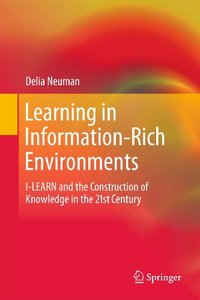Learning in Information-Rich EnvironmentsI-LEARN and the Construction of Knowledge in the 21st Century
|

|
 Diese Seite wurde seit 1 Jahr inhaltlich nicht mehr aktualisiert.
Unter Umständen ist sie nicht mehr aktuell.
Diese Seite wurde seit 1 Jahr inhaltlich nicht mehr aktualisiert.
Unter Umständen ist sie nicht mehr aktuell.
 Zusammenfassungen
Zusammenfassungen
 The amount and range of information available to today´s students - and indeed to all learners - is unprecedented. Phrases like 'the information revolution', 'the information (or knowledge) societ', and 'the knowledge economy' underscore the truism that our society has been transformed by virtually instantaneous access to virtually unlimited information. Thomas Friedman tells us that 'The World Is Flat†and that we must devise new political and economic understandings based on the ceaseless communication of information from all corners of the world. The Bush administration tells us that information relating to the 'war on terrorism' is so critical that we must allow new kinds of surveillance to keep society safe. Teenage subscribers to social-computing networks not only access information but enter text and video images and publish them widely—becoming the first adolescents in history to be creators as well as consumers of vast quantities of information.
The amount and range of information available to today´s students - and indeed to all learners - is unprecedented. Phrases like 'the information revolution', 'the information (or knowledge) societ', and 'the knowledge economy' underscore the truism that our society has been transformed by virtually instantaneous access to virtually unlimited information. Thomas Friedman tells us that 'The World Is Flat†and that we must devise new political and economic understandings based on the ceaseless communication of information from all corners of the world. The Bush administration tells us that information relating to the 'war on terrorism' is so critical that we must allow new kinds of surveillance to keep society safe. Teenage subscribers to social-computing networks not only access information but enter text and video images and publish them widely—becoming the first adolescents in history to be creators as well as consumers of vast quantities of information.If the characteristics of 'the information age†demand new conceptions of commerce, national security, and publishing - among other things -it is logical to assume that they carry implications for education as well. In fact, a good deal has been written over the last several decades about how education as a whole must transform its structure and curriculum to accommodate the possibilities offered by new technologies. Far less has been written, however, about how the specific affordances of these technologies - and the kinds of information they allow students to access and create - relate to the central purpose of education: learning. What does 'learning' mean in an information-rich environment? What are its characteristics? What kinds of tasks should it involve? What concepts, strategies, attitudes, and skills do educators and students need to master if they are to learn effectively and efficiently in such an environment? How can researchers, theorists, and practitioners foster the well-founded and widespread development of such key elements of the learning process?
This book explores these questions and suggests some tentative answers. Drawing from research and theory in three distinct but related fields - learning theory, instructional systems design, and information studies - it presents a way to think about learning that responds directly to the actualities of a world brimming with information. The book is grounded in the work of such key figures in learning theory as Bransford and Anderson & Krathwohl. It draws on such theorists of instructional design as Gagne, Mayer, and Merrill. From information studies, it uses ideas from Buckland, Marchionini, and Wilson (who is known for his pioneering work in 'information behavior' ”that is, the full range of information seeking and use). The book breaks new ground in bringing together ideas that have run in parallel for years but whose relationship has not been fully explored.
 Kapitel
Kapitel 
- 1. Information as a Tool for Learning
 Dieses Buch erwähnt ...
Dieses Buch erwähnt ...
 Dieses Buch erwähnt vermutlich nicht ...
Dieses Buch erwähnt vermutlich nicht ... 
 Nicht erwähnte Begriffe | K1 knowledge / Wissen, K2 comprehension / Verständnis, K3 application / Anwendung, K4 analysis / Analyse, K5 synthesis / Synthese, K6 evaluation / Beurteilung, Kognitivismus, Taxonomie von Bloom (affektiver Bereich), Taxonomie von Bloom (psychomotorischer Bereich) |
 Tagcloud
Tagcloud
 Zitationsgraph
Zitationsgraph
 Zitationsgraph (Beta-Test mit vis.js)
Zitationsgraph (Beta-Test mit vis.js)
 2 Erwähnungen
2 Erwähnungen 
- The Inverted Classroom Model (Eva Großkurth, Jürgen Handke) (2014)

- Education andTechnology - Key Issues and Debates (3rd edition) (Neil Selwyn) (2022)

 Volltext dieses Dokuments
Volltext dieses Dokuments
 Bibliographisches
Bibliographisches 
 Beat und dieses Buch
Beat und dieses Buch
Beat hat dieses Buch während seiner Zeit am Institut für Medien und Schule (IMS) ins Biblionetz aufgenommen. Beat besitzt kein physisches, aber ein digitales Exemplar. (das er aber aus Urheberrechtsgründen nicht einfach weitergeben darf). Es gibt bisher nur wenige Objekte im Biblionetz, die dieses Werk zitieren.









 Informationsflut
Informationsflut Informationsgesellschaft
Informationsgesellschaft Lernen
Lernen Problemlösefähigkeit
Problemlösefähigkeit




 , 3283 kByte)
, 3283 kByte) 



 Biblionetz-History
Biblionetz-History